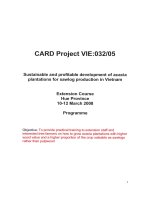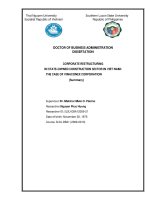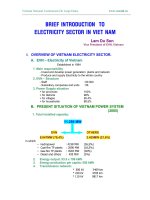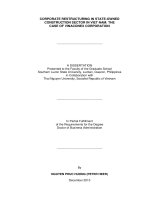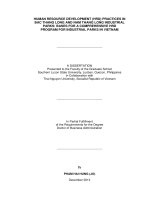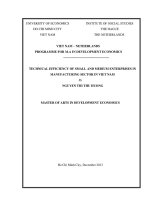IR 4 0 OPPORTUNITIES FOR HEALTHCARE SECTOR IN VIET NAM
Bạn đang xem bản rút gọn của tài liệu. Xem và tải ngay bản đầy đủ của tài liệu tại đây (439.6 KB, 79 trang )
MINISTRY OF EDUCATION AND TRAINING
FOREIGN TRADE UNIVERSITY
MASTER THESIS
IR 4.0: OPPORTUNITIES FOR HEALTHCARE
SECTOR IN VIET NAM
Specialization: Master of Research in International Economics
DINH THI HONG HANH
Hanoi – 2020
MINISTRY OF EDUCATION AND TRAINING
FOREIGN TRADE UNIVERSITY
MASTER THESIS
IR 4.0: OPPORTUNITIES FOR HEALTHCARE
SECTOR IN VIET NAM
Major: International Economics
Specialization: Master of Research in International Economics
Code: 1806410005
Full name: Dinh Thi Hong Hanh
Supervisor: Prof. Dr. Tu Thuy Anh
Hanoi – 2020
i
TABLE OF CONTENTS
ACRONYMS AND ABBREVIATIONS ............................................................. iv
LIST OF FIGURE AND TABLE ........................................................................
vi ABSTRACT……………………………………...…………………………………
1
INTRODUCTION ................................................................................................
. 2 CHAPTER 1- APPLICATIONS OF INDUSTRY 4.0 IN HEALTHCARE ........
5
1.1 The fourth industrial revolution .................................................................. 5
1.2 Healthcare 4.0 .............................................................................................
12 1.2.1.
Robot .................................................................................................... 12 1.2.2
Three-dimensional model ..................................................................... 12
1.2.3. Internet of things ................................................................................. 12
1.2.4. Big data ................................................................................................ 13
1.2.5. Artificial intelligence............................................................................ 13
1.3. Overview of healthcare system in Vietnam ..............................................
22 CHAPTER 2- OPPORTUNITIES OF INDUSTRY 4.O FOR HEALTHCARE
SECTOR IN VIETNAM ....................................................................................
24 2.1 Vietnam under Industry
4.0 ...................................................................... 24 2.2. Healthcare digital
technology in Vietnam ............................................... 28 2.2.1 Vietnam
proposes the route of making hospitals intelligent ................. 28 2.2.2 Health
ID issued to citizens .................................................................. 29 2.2.3
Digitalisation of healthcare feild, double-edged sword ........................ 30 2.2.4
Affairs on high-teach healthcare complex beginning in Hanoi ........... 32 2.3.
Hospital digitalization ............................................................................... 34
2.3.1. Medical examination treatment management ........................................
34 2.3.1.1. Increase of healthcare on
demand .................................................. 35 2.3.1.2 Mobile application
technology is personalized ................................ 36 2.3.1.2.1 Searching by
voice .................................................................... 36 2.3.1.2.2 Development
of wearable medical devices ................................. 37 2.2.1.3 Artificial
Intelligence ....................................................................... 37 2.2.1.3.1 AI and
forecast analytics .......................................................... 37
ii
2.3.1.3.2 Wonders of Artificial Iintelligence .................................................. 38
2.3.1.4 Blockchain ...........................................................................................
39
2.3.1.4.1 Blockchain and promise of better electronic health
record.
...........
39
2.3.1.4.2
Healthcare ............................................................... 40
Blockchain
in
2.3.1.4.3 Blockchain
integration ................................................................... 41
2.3.1.5 Virtual
Reality ....................................................................................... 42
2.3.1.5.1
Interaction environment ................................................................ 42 2.3.1.5.2
Patient treatment by virtual reality ................................................. 43
2.3.2
Hospital Digitalization in Viet Nam .......................................................... 44
2.3.2.1 Hospital going digital ....................................................................... 44
2.3.2.2 Government support for digitalisation in healthcare ......................... 48
2.4. Opportunity of utilizing big data in healthcare ..........................................
50
2.4.1 Benefits of Cloud computing for healthcare ..........................................
51
2.4.1.1
Unlimited
capacity ............................................................................. 52 2.4.1.2 Reliable
broadening capacity ........................................................... 52
2.4.1.3. Seamless cooperation…………………………………………………….
52 2.4.1.4. System security
increase .................................................................. 53
2.4.1.5.Accessing AI and Machine Learning .............................................. 53
2.4.1.6. Remote care opportunity ................................................................. 53
2.4.1.7 Advantages of data orientation for medical insurance ..................... 54
2.5. Strengthening healthcare sociallization .......................................................
55
2.5.1
Vision
........................................................................................................
58
2.5.2 Implementation .........................................................................................
60 CHAPTER 3 – EXPERRIENCES OF APPLYING INDUSTRY 4.0 IN
HEALTHCARE IN SELECTED COUNTRIES ............................................... 68
3.1. Hospital digitalization in US
3.1.1 IoT concept involves digitalization of medical products and related
care
processes .....................................................................................................
...
70
3.1.2
Mobile
devices
and
applications
into
helthcare .................................... 71 3.1.3 Big data in medical system
management .............................................. 73 3.1.4 New digital health
consultant generation ............................................. 76
iii
3.2. Integrated care model based on capacities of IR 4.0 in Weston european
78
3.2.1
Care
4.0 ................................................................................................. 78 3.2.
2 Healthcare policies .............................................................................. 79
3.2.2.1 Academic merging co-design in Scotland ........................................ 81
3.2.2.2 Building faith in systems and in the whole population ..................... 83
3.2.2.3. Activating renovation culture .......................................................... 83
3.3.
Socializing
healthcare
China .................................................................... 99
in
3.4 Digitalisation of
healthcare: digital health enablers in Vietnam .............. 106 CHAPTER 4INVESTMENT
OPPORTUNITIES
HEALTHCARE
IN
VIETNAM'S
DIGITAL
................................................................................................
114
4.1. Policy and management: Adjusting our society to change fast in the
medical and healthcare ecosystem ................................................................
114
4.2.
Incresasing
many
investments
into
Information
technology ................. 115 4.3 Policy and technology renovation challenges
in healthcare 4.0 ............ 117
CONCLUSION ..................................................................................................
121
REFERRENCES ...............................................................................................
122
iv
ACRONYMS AND ABBREVIATIONS
TERM DEFINITION
AI Artificial Intelligence
IoT Internet of Things
ILO International Labour Organization
STEM Science, Technology, Engineering and Mathematics VR
Virtual Reality
CPS Cyber Physical System
IOS Internet of Services
SERP Smart Enterprise Resource Planning IR
Industrial Revolution
GSO General Statistics Office
ICT Information and Communications Technology ASEAN
Association of South East Asian Nations MOH The Ministry
of Health
CRM Customer Relationship Management DHI
Digital Health and Care Institute
HMO Health Maintenance Organization
MIP Ministry of Planning and Investment CIEM Central
Institute for Economic Management VHEA Viet Nam
Health Economics Association EHR Electronic Health
Record
CMS Medicare and Medical Services
BMI Business Monitor International
CDC Centers for Disease Control
GIS Geographic Information Coalition
CHCs Commune Health Centers
TCF Textiles, Clothing and Footwear
E&E Electronic and Electric
v
MOOCs Massive Online Open Course
AIC Asia Internet Coalition
AWS Amazon Web Services
DA Doctor Anywhere’s
VR Virtual Reality
CAGR Compound Annual Growth Rate
mIoT Medical Internet of Things
NLP Natural Language Processing
LOINC Logical Observation Identifiers Names and Codes US
United States
UK United Kingdom
vi
LIST OF FIGURE AND TABLE
Figure 1.1: Capabilities of Industry 4.0 in the medical field IoT, Internet of
things………………………………………………………………………………
…….14
Table 3.1: The 4.0 toolset applied across care organization…………………….90
1
ABSTRACT
The fourth industrial revolution is currently proceeding and is expected to
significantly affect the way individuals live and in result change the society in
various aspects. The ICT-based convergence industries of the fourth industrial
revolution contain various fields. This thesis examines the researches done in
fourth
industrial revolution in medical field. This study also suggests
necessary contents in the fourth industrial revolution to be focused on for
further research in this field.
2
INTRODUCTION
1. The importance of the study
Vietnam’s healthcare landscape is changing. The country’s strong economic
and population growth is creating a new middle class which is demanding
higher quality medical treatment. These affluent, digitally-literate consumers
are spending more on their healthcare, leading to a rise in demand for private
providers and digital health services. The population of Vietnam is not just
becoming richer. It is also growing older. This is resulting in a shift in the
burden of disease from communicable to non-communicable conditions like
diabetes
and
cancer.
These
non-communicable
conditions
require
coordinated, long-term care solutions. Meanwhile, Vietnam is embracing the
Fourth Industrial Revolution. Internet access is widespread and the country
has seen rapid development in 4G and 5G mobile
communication
technologies. Building on these foundations, the government of Vietnam is
driving a digitalisation agenda in hospitals and clinics across the country.
Smart solutions are being strongly encouraged that utilise big data, artificial
intelligence (AI), cloud computing and mobile technology to help alleviate
Vietnam’s overcrowded public hospitals and increase quality of care. Together,
these factors are opening up new opportunities for companies in Vietnam’s
digital healthcare space. We looks at the enablers for the adoption of digital
healthcare solutions in the country, as well as some of the difficulties that face
new market entrants. The report gives an overview of Vietnam’s healthcare
landscape – including its challenges and opportunities – and describes the
main domestic and international players already operating in the market. It
also includes key commercial opportunities available for companies as well as
some tips on doing business in Vietnam’s emerging digital health sector.
In area-wise research on Industry 4.0 in medical, we observed that the
computer science area provides the maximum contribution of 31% in total
research publications. However, the overall engineering field contributes 25%;
decision
sciences and mathematics contributing 11% each; business,
management and ac
counting 6%; materials science 4%; biochemistry, genetics and molecular biology
3
2% and other fields 10%, which includes energy, health professions,
pharmacology,
toxicology and pharmaceutics, physics and astronomy,
psychology and social sciences. Industry4.0 in the medical field is increasing
and research and
development are progressing towards providing
commercially viable and acceptable solutions for the medical field. Industry4.0
in the medical field is increasing and
research and development are
progressing towards providing commercially viable and acceptable solutions
for the medical field. Industry 4.0 focuses on the design and manufacturing
and helps perform different cases precisely. Industry 4.0 provides extensive
contributions in the medical field with the help of innovative designing and
smart manufacturing system. Industry 4.0 provides excellent
flexibility to
create smart industrial and medical models which help to improve
communication between doctors and patients. In future, Industry 4.0 will move
towards mass production systems and adapt to the world-class manufacturing
system. It enables to create smarter medical products in lesser time and cost.
This
revolution will change all management and treatment system of the
patient. With the help of smart manufacturing technologies, medical students
can be well trained
to detect problems and correlate them to take future
action. In the medical field,it can help to increase overall performance by
providing a digitally controlled management system to the patients. It provides
precise surgery to the patient by the applications of additive manufacturing,
sensors, holography, robots, AI, big data
and IoT devices. Industry 4.0
bringing upon innovation with the help of holography
and visual reality.
Doctors and surgeons can take advantages of this revolution for research,
development and excellent service to the patient. In the upcoming years, it
will provide disruptive innovations to the medical field.
2. Research question and Objectives of the study
The study has two main objectives:
- Firstly, Fourth Industrial Revolution
- Secondly, opportunities of Industry 4.0 for healthcare in
Vietnam To get above objectives, the study addresses 3 issues:
- Development of Industry 4.0 in Vietnam
4
- Experience of countries: US, China
- How does Industry 4.0 bring opportunities and solutions in medical field in
Vietnam?
3. Subjects, scope and data of the study
Subject of the study: Vietnam is embracing the Fourth Industrial Revolution.
Health and healthcare solutions in the Fourth Industrial in Vietnam Scope of
the study: US, China, Europe, Vietnam
By using secondary data from reliable sources such as Ministry of Health,
Ministry Science and Technology from government and enterprise. 4.
Methodology
To reach the objectives, the author uses combination of research
methodologies: - Researching on primary and secondary documents to
have the theoretical basis, such as curriculums, research papers, science
reports and so on. - Descriptive statistics method: After collecting data
from reliable sources, the author proceeds to arrange, analyze and
compare data as well as other documents to have a particular and a
concision
5. Structure of the study
- Chapter 1: Applications of industry 4.0 in healthcare
- Chapter 2: Opportunity of Industry 4.0 for healthcare in Vietnam - Chapter
3: Experiences of applying Industry 4.0 in healthcare in selected countries
- Chapter 4: Investment opportunities in Vietnam’s digital healthcare
5
CHAPTER 1- APPLICATIONS OF INDUSTRY 4.0 IN
HEALTHCARE
1.1 The fourth industrial revolution
The Fourth Industrial revolution, like the others before, was born in
manufacturing connecting everything to the internet, generating data across
the whole process, and using advanced analytics to support completely new
products and service models
Focusing first on a Smart Factory, the initial premise was to create a
better connected production line and generate decision support to workers to
keep the line running at maximum efficiency, removing waste, and minimizing
costs. Over time the quality and configuration of products could be changed
more flexibly.
Connectivity then expanded outside of the factory to other
factories to optimize stock levels and ordering. Industry 4.0 now includes full
value chain monitoring, including how the product is used, delivered, and
maintained, creating a feedback loop to design and build and target products
better in the future, keeping businesses
competitive in a fast-evolving
marketplace. This revolution must meet needs at a massive industrial scale
and is projected to be worth $214 billion by 2023.
The Industry 4.0 toolset includes :
• Cyber Physical System (CPS)—a connected, automated device, capable
of learning from and effecting the physical environment, that is intelligent and
responsive and can act independently (e.g., self-diagnosing problems) or
interdependently with humans or other CPSs to achieve efficiencies or resolve
issues.
• Internet of Things (IOT)—the network over which CPSs can connect to the
internet and to each other in a secure, auditable manner.
• Internet of Services (IOS)—when devices are networked over the IOT, new
services focusing on logistics, intelligence, automation and prediction are
possible. • Smart Factory—the combination of cyber-physical systems and
humans, connected through the internet of things with support from the
internet of services, monitor production processes, and make de-centralized
decisions as part of an
6
interdependent network. The factory management is orchestrated via smart
enterprise resource planning (SERP) systems and supported by human and
virtual agents to develop product that is responsive in real time to demand,
market conditions, and value chain (e.g., logistics) feedback.
The toolset applied within the context of manufacturing and provides a
baseline capability map for an overarching ‘4.0’ toolset which can be applied
to different sectors and delivery models. Subsequent sections will consider
other applications of this toolset in emerging next generation models of health
and social care. For these discussions the ‘smart factory’ has been jointly
labelled a ‘virtual agent’ to allow the concept to better cross sectors. The
largely automated intelligent oversight of an interconnected system is a ‘smart
factory’ in a manufacturing context, but in a care setting it is more likely to be
a virtual assistant that translates between the system and the people within it,
wherever they are.
Since the World Economic Forum’s action on Industry 4.0, many people
have
attempted to respond to the early challenge and opportunity. The
concept is still maturing, with discussion around the difficulty of defining this
complex web of
technologies and principles. Contributors instead
characterize Industry 4.0 through
several different lenses. For example,
arguing that it can only be fully characterized
by the changing the way
organizations, business models and markets work to optimize the benefits
from the technology. A second characterization looks at how the relationships
between actors differs from previous revolutions—with the first and second
revolutions operating as a centralized network, the third revolution as a
decentralized network with multiple, powerful hubs, while the fourth revolution
will constitute a distributed network made up of interconnected nodes with
equal power. The implications are that given the way the connected value
chain reaches well
beyond the physical confines of a factory, these
technologies will change how society organizes itself, with power and assets
redistributed (though not necessarily for societal good).
7
Countries all around the world are now standing on the brink of h
technological revolution, commonly called the Industrial Revolution (IR) 4.0.
Asia & Pacific region is the case in point, and most particularly Viet Nam,
where rapid
technology innovation and adoption at the workplace are
diffusing faster than ever before, with some variations across sectors. This
policy briefs introduces some of the opportunities and challenges for the world
of work.
What is IR 4.0?
Previous industrial revolutions have been characterised by the adoption
of various techniques for production. “The First Industrial Revolution used
water and steam power to mechanize production. The Second used electric
power to create mass production. The Third used electronics and information
technology to
automate production. Now a Fourth Industrial Revolution is
building on the Third with the digital revolution occurring since the middle of
the last century. It is characterized by a fusion of technologies that is blurring
the lines between the physical, digital, and biological spheres. In its broad
definition, IR 4.0 is characterised by rapid technological advancement through
increased use of mobile
communication and interconnectivity (‘internet of
things’), big data, artificial
intelligence, robotics, autonomous vehicles, 3D
printing, Nano and biotechnology, quantum computing etc. What could be the
impacts of IR 4.0 in the world of work in Viet Nam? With the transformation of
entire systems of production, management and governance, the IR 4.0 offers
a wide spectrum of opportunities and challenges in the world of work, with
direct and indirect impacts on sectors across the
economy (agriculture,
industry and services) as well as categories of workers including the most
vulnerable groups (youth, women etc.).
Technology as creator and transformer of jobs
Technological advances can support structural transformation of the
economy (shift away from the agriculture to the manufacturing and services
sectors) by
facilitating labour mobility of workers across sectors and
occupations and/ or easing
work by lifting up workers from cumbersome
tasks.
8
In the agriculture sector, the adoption of mechanisation is key for labour
productivity increases and the diversification of the rural economy With two
thirds of the labour force in rural areas, employment in agriculture, forestry
and fishery sector is widespread, accounting for roughly 40 percent of total
employment in 2017. While the sector’s growth has slowed down over the last
decades, there is still
some great untapped. GSO potential in off-farm
activities and diversification in the non-agriculture sector in rural areas with
productivity gains arising from mechanisation”. For example, the expansion of
e-agriculture5 has the potential to enhance agriculture, forestry and fishery
outputs and foster rural development through the emergence of “green jobs”6.
Within the manufacturing sector, adoption of technology advancements has
the potential to shift workers to higher skilled
occupations with higher
productivity. The ILO report “ASEAN in transformation: How technology is
changing jobs and enterprises transformation” indicates that majority of total
employment in the manufacturing sector, particularly in the textiles, clothing
and footwear (TCF) and electronic and electric (E&E) sectors, will
be
impacted by IR 4.0. While high-tech has not yet completely entered the
industries, there are some signs of penetration in industries. Trade, foreign
direct
investment and associated technology have all contributed to
productivity growth. In those industries, significant changes in the medium to
long term are most likely to occur due to disruptive technologies, for example
in 3D printing technology, industrial robots, Internet of Things (iv) computeraid
designs, and body scanners etc.7 In turn, subsectors in engineering, transport
and infrastructure will likely boost demand for jobs. The digital revolution has
the potential to shift workers to more customeroriented jobs in the service
sector . Technology advancement also leads to a rise of the “gig economy”
where a number of jobs are increasing being performed
through online
platforms (Uber, Grab, e-commerce). Ultimately, the adoption of
new
technology innovations could improve workplace safety, increase productivity,
wages and stimulate aggregate demand, combined with anticipated increase
of FDI inflow and easier access to major export markets arising from FTAs,
particularly
CPTPP and EU-Viet Nam FTA, once ratified. As productivity
increase and working
9
conditions improve, this can further lead to a reduction of working hours and
creation of more leisure services and products. Ensuring workers’ protection
and decent work in the context of the IR4.0 Technology per se is neither good
nor bad as technology cannot automate all tasks that require for example
perception and
manipulation, creative intelligence and social intelligence.
Therefore, supporting workers and their protection in this process of rapid
changes remains crucial. In
particular, the importance of the informal
economy together with the rise of casualization and nonstandard forms of
employment put concerns on workers’
protection and the quality of
employment as the employment relationship (employer/employee) becomes
more blurry.
How to maximize the use of IR 4.0? Some
examples
Agriculture sector:
Technological advancement has been used in multiple ways in the
agriculture
sector in developed economies through increased use of
technology and
productivity (direct
mechanisation in production to increase agricultural
contribution) or through the use of ICT as a tool to
empower farmers to take informed decisions (indirect contribution). Specific
examples of using ICT include
the use of smartphone mobile apps in
agriculture, the use of Geographic Information Systems (GIS) for farming and
fishing or satellite technologies and other agronomy sciences that increased
significantly agriculture and fishing outputs. Consumers and producers are
also increasingly aware and conscious of ecological matters, fair trade and
the importance of agricultural biological products with their
specific
characteristics as opposed to chemical products and mass production. The
use of ICT to promote these biological and organic products is often used to
sale
and promote quality products together with a range of strategies
including packaging, sizing and pricing.
Industries:
The use of high-tech technologies is most commonly found in industries.
In industrialised economies, technologies have been used in multiple ways in
order to
10
boost efficiency (both quality and quantity) and raise productivity. As
examples, successful Asian economies like Singapore, South Korea, Taiwan
and Malaysia have achieved their economic miracles with strong industrial
development policies that placed a strategic focus on specific export-oriented
sectors. In all cases, education and training policies have prepared the labour
force for entry into targeted industries, by helping to absorb the know-how
and technology from the rest of the world and to diversify into new and more
sophisticated products. In Singapore, for example, the share of high-skill and
technology-intensive manufacturing exports
represents almost 50% of the
workforce.
Service sectors:
The use of mobiles devices and increased widespread access to internet
has fundamentally changed the world of work. The rise of the gig economy,
digital platform, freelancing and ecommerce, bring up new forms of work that
can be performed remotely (or partly). They also significantly contributed to
expand
markets beyond borders by connecting an increasing number of
people. On-line
learning is increasingly used to foster skills’ development
throughout the life cycle. For example, the use of online courses such as
MOOCs (Massive Online Open Course) expand opportunities for youth to
learn and share knowledge at a minimal cost on a variety of topics. What
could be the priority areas of action for Viet Nam’s labour market? The 4th
Industrial Revolution is here and cannot be avoided, yet the extent to which it
penetrates different sectors of the economy varies. While the impacts on the
jobs are difficult to predict, some ingredients are critical to carefully manage
the process of transformation. In doing so, barriers to occupational,
geographical and sectoral mobility need to be removed. Moving up the skills
ladder Having the right skills to increase the ability to adapt to the need of
the
labour market and drive the process of technological advancement
forward is critical. A combination of both technical skills (such as STEM) and
core skills
(creativity, critical thinking, communication, teamwork etc.) are
needed to best equip the labour force and foster resilience to the evolving
labour markets. Training, (multi) skilling, reskilling, lifelong learning throughout
the life cycle are all critical
11
in and out of the job. Education and training systems must be prepared to
develop skills for the future. In particular, partnership between policymakers,
business and training providers are required to ensure adequate supply with
demand in the labour market. Sectoral approach to employment creation
(incl. industrial policies) As Viet Nam will increasingly witness the impact of
technological change at the
workplace, the effects will vary considerably
across sectors. An effective development strategy calls for expanding sectors
that generate more value-added and employment, with large multiplier effects
and upstream and downstream
linkages to the domestic economy. The
importance of industrial and other sectoral
strategies for structural
transformation could be reasserted in light of the national, regional, and global
developments. The new growth model would need to be, in
order to be
inclusive and sustainable, built around higher technological value-added and
productive sectors that nurture quality employment and other qualitative
dimensions of the domestic economy. The importance of labour market
governance Viet Nam could increasingly compete in global markets based on
higher productivity and better working conditions. But translating productivity
growth into better wages and higher living standards requires effective labour
market institutions, which include effective legal protection of workers’ rights
in various
forms of employment, representation of workers’ voice, and
collective bargaining.
Effective industrial relations is a key for stability,
productivity and equity, which
will ensure sustainable and inclusive
development. Active labour market policy
and social protection With
accelerated changes under IR.4.0, workers who are more frequently moving
from one job to another will need to be supported. Effective ‘active labour
market policies’ that help to connect people with jobs are
important to
constantly help workers to develop new skills; ensure smooth transition from
one job to another; provide skill training and unemployment insurance during
the gaps between the jobs. Only with proper social protection,
including
unemployment insurance, workers’ move from lower to higher productivity
sectors and jobs will be facilitated.
12
1.2 Healthcare 4.0
“In a complex world that is advancing rapidly at an exponential pace
where nearly every sphere of human existence seemingly finds the internet
indispensable, therein lies profound benefits to be gained at the convergence
of virtual reality,
simulations, big data analytics and Artificial Intelligence.
Healthcare is no exception. Sophysicians, health economists and healthcare
administrators of this generation and beyond ultimately have to thrive in such
a technological
environment to remain relevant in the medical profession
which provides care for the population in the modern age of digitalisation.
1.2.1. Robot
Robots are used to perform surgery and provide improved performance,
movement and control. Now, surgery can be per-formed through computer
control. It reduces/eliminates tissue trauma in open heart surgery case. It can
also work in an environment that is felt dangerous for surgeons.
1.2.2 Three-dimensional model
Holography is a noncontact 3D imaging that can be seen by anaked eye.
It provides details of the human anatomy, tissue, bones and activity of an
internal organ of the body with high resolution. Doctors can now see the
patient in a holographic image without the physical presence of the patient. It
is an excellent
tool for con-tactless study which is used to measure the
internal and external
fracture. Holography has excellent potential to
addresses the challenge of storing the complex issue of 3D image storing of
thepatient. Patient diseases/other information can be stored digitally which
can be helpful to train medical student
Sensors provide information about temperature, blood pressure and
other conditions of the patient. Different types of sensors are used as per the
requirement of the medical field.
1.2.3. Internet of things
IoT has opened up a world of possibilities in medicine. It connects the
Internet and medical devices and collects valuable in-formation to provide
control over
13
patients' lives and treatment. It is helpful in monitoring, treatment and testing
to provide satisfaction to the patient.
1.2.4. Big data
In health care, big data provides life-saving outcomes. By the digitisation,
it referred to vast quantities of information and analysed it. Doctors required
an understanding of patients' past for their best treatment, so this technology
is helpful to provide valuable information regarding patients such as the sign
of illness. It also provides relevant critical insights into better care and faster
treatments
1.2.5. Artificial intelligence
In medical field, AI is used to analyse complex medical data. It is an
essential technology that is programmed and controlled by machines with the
help of the computer. It has the ability to gain information and well-defined
output to doctors
and patients. AI provides prevention and treatment
technique to improve patient outcome. It is helpful in personalised medicine,
diagnosis processes, disease level,
drug development and patient
monitoring.6. Different capabilities of Industry 4.0 in
the medical field .
Industry 4.0 could provide exciting capabilities and new
opportunities for
patient care. It individualises products with the precise
manufacturing of
patient-specific devices, which creates ahigh-quality result. It also positively
impacts the hospital
14
Figure 1.1: Capabilities of Industry 4.0 in the medical field IoT,
Internet of things
Source: Industry 4.0 applications in medical field: A brief review
Applications Description
1 Customisation of implants
famous because of the
- The customisation is the primary
manufacturing of the customised product,
requirement of the medical field because
so it can quickly create highquality implants
data of every patient specific implants and and devices in lesser time and cost
devices are different - Industry 4.0 is
2
Digital hospital
- Industry 4.0 provides better information
management in medical by the application of
IoT - Helpful in keeping medical record,
physician,
sample
and
laboratory
identification
15
- By the applications of digital technologies used in
Industry 4.0, symptoms and cause of diseases are
easily identified
3 Smart implants - Efficient manufacturing of smart medical components and
the same can communicate with
monitoring systems and remote physicians
- It evolves in the part of the internet of service
and opens a new era of opportunities in the
medical field
- By the applications of smart material, implants
can change the shape with increase in temperature
concerning time as per requirement
4 Designing and manufacturing of
devices and models in lesser time
surgical tools
- Also used for upgradation of tools and
and devices
- Industry 4.0 can play a useful role in the
devices by the application of additive
manufacturing - Implants manufactured by
design and production of implants, surgical smart manufacturing technology fit the
tools, biomodels and all other medical
patients comfortably
5
Management
- During unusual circumstances such as
during a medical
critical illness or unavailability of any family
emergency
members, technologies are reliable to easily
identify
previous medical history of the
patient such as name, age, blood group, etc.
- Provide more time for treatment by speedy
admission procedure - Provides 3G video
equipment in an ambulance
by which
doctors can also image the condition of the
patient before admitting
6 Provides implants in lesser time
7 Cost-effective for the hospitals
8 Improved accuracy as per patient match Digitally controls all the system in the
16
hospital and provides excellent service to
- Build a customised model in lesser time
the patient - Highly reliable for
with required mechanical strength
manufacturing of a customised product
- Helpful to create a conceptual model for
which correctly fits the patient - A
medical applications - By the applications of customised implant as per patient data
reduces risk and surgery time
different advance designing and
manufacturing technologies, implants and - Models/parts manufactured by smart
other medical devices are created in lesser manufacturing technology have good
time
accuracy and surface finish - Using good-
- Produces any medical devices,
quality material accuracy is improved
instruments or implants at a lower cost -
- Provides satisfaction to the patient
9
Multimaterial
- Smart manufacturing technology uses
implants, tools
multimaterials as input material -
and devices
Multimaterial-printed implants provide exact
with
information such as defects in the bone of the
excellent strength
patient
- These multimaterial medical models help
the surgeon for a better understanding of the
patient-
17
specific problem before surgery
10 Provide flexibility - Industry 4.0 provides excellent flexibility during a
complicated surgery
- Traces the cause of diseases by predicting data
of different patients
- Flexibility to create industrial parts, medical
models, cultural artefacts and also other dental
models
11 Improved research and development
- Industry 4.0 provides essential direction
for the research and development of
- Industry 4.0 helps to efficiently
personalised prostheses and other
manufacture a prototype, and this
implants/ devices.
prototype is to be tested and used for
research & development purposes
12 Precise for surgeons - Medical parts and components manufactured by this
process performed precise
surgery because smart manufacturing system
produces an exact fit model.
- Easy handling of different complex cases
13 Improve
and patient.
communication
- Medical model manufactured by smart
- Doctors and surgeons can better
manufacturing systems can improve the
communication between doctor/surgeon
14
Reduces
surgery risk
understand the treatment outcomes and
provide appropriate information to the
patient
- Industry 4.0 uses sensors and innovative
manufacturing
15 Reduces inventory of implants
16 Identifies the level of diseases
18
technology which has the potential to
reduce the surgery risk - Quickly identifies
the problems for complicated cases
- Performs surgery efficiently which
increases the success rate of operatio
- Industry 4.0 is famous because of the
stored digitally
customisation, which can manufacture any - By the use of different scanning process
shape implant
and technique, patient data are used
- Reduces inventory cost because implants efficiently - Helpful to identify different
are produced as per the individual demand diseases and their causes by taking data
- By the use of digitisation, it also reduces
from various patients - Also helpful to
the paperwork because patient data are
identify the level of diseases
17
Holography
- Industry 4.0 uses holography to display
medical data of the whole patient in a threedimensional
tomographic image - Doctors
can see patient data in multiangular view
without the presence of the patient
- Holography is an emerging and powerful
tool for medical
applications used in orthopaedics, pathology,
tissue,
dentistry,
ophthalmology,
otology,
urology and cardiology
19
18 Virtual reality - In medical, virtual reality can provide needful information to
doctors and patients
- Provides a 3D view of the patient's data
- Improves the quality of surgical planning
- Reduces planning time of
complicated surgery
- Provides surgical skills to surgeons using
simulation and investigates each organ of the
human body in a better way
19
Complete
monitoring
- Easily monitors the whole treatment process
of the patient by recording all data - Helps to
monitor and avoid public health problem with
the help of different medical devices
and
technologies - Increases the quality of
medical
treatment
management cost
with
optimised
